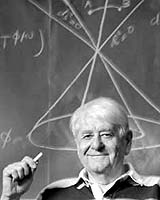This is a real hot off the press Friday Galaxy, the data for this was only taken last night, in Chile, by those very helpful people at the Gemini-South telescope. I'm using the 12 images they took (4 each of g',r' and i', that's blue, green and red to you and me) to pick out Globular Clusters for spectroscopic follow up.
The image below shows the image produced, there are a couple of odd things about this image. The first is that the galaxy itself is very blue, for an elliptical galaxy this is odd, these are usually known as being red and dead, because they don't form stars. At first I thought I had mixed up the blue and red channels, however in the top left corner you can see a very pretty background edge on spiral and this appears to be just the right colour for a spiral, hmm.
If we assume that the colours are correct and that we are seeing a blue elliptical galaxy, then their are two possibilities: Either some fraction of the galaxy is made up of hot young blue stars, which can't have been formed more than a few Gyrs ago (not that common for ellipticals), or else the galaxy must be very old and lacking in metals. This is one of the major drawbacks of using the colours of astronomical objects like galaxies to tell you about them, there is a degeneracy between the age of stellar populations and the amount of elements heavier than Helium that they contain (their metallicity). Basically things can appear blue for one of two reasons, they are either young, or they have a low metallicity (and are old).

To solve this conundrum will require spectroscopy, which hopefully we will be getting in the next few months. One other interesting thing that appears in this image can be seen in the top left, when you look at the spiral galaxy (shown enlarged below) you can just about make out what appears to be a stream of material trailing to the bottom right. This trail, if real, could be a trail of stars produced by a minor merger event, if I get the chance and have the space when I make up the mask for the spectroscopy I may well try and get a sly spectrum of this just to see whats going on.

That just shows you one of the cool things about astronomy, serendipity means you can find all sorts of interesting things in the unlikliest of places. There are loads of interesting things in the background of deep images like this one, if anyone finds anything interesting in the large version of the image, let me know, you never know I may try and get a spectrum of anything you find that looks interesting enough.
The image below shows the image produced, there are a couple of odd things about this image. The first is that the galaxy itself is very blue, for an elliptical galaxy this is odd, these are usually known as being red and dead, because they don't form stars. At first I thought I had mixed up the blue and red channels, however in the top left corner you can see a very pretty background edge on spiral and this appears to be just the right colour for a spiral, hmm.
If we assume that the colours are correct and that we are seeing a blue elliptical galaxy, then their are two possibilities: Either some fraction of the galaxy is made up of hot young blue stars, which can't have been formed more than a few Gyrs ago (not that common for ellipticals), or else the galaxy must be very old and lacking in metals. This is one of the major drawbacks of using the colours of astronomical objects like galaxies to tell you about them, there is a degeneracy between the age of stellar populations and the amount of elements heavier than Helium that they contain (their metallicity). Basically things can appear blue for one of two reasons, they are either young, or they have a low metallicity (and are old).

To solve this conundrum will require spectroscopy, which hopefully we will be getting in the next few months. One other interesting thing that appears in this image can be seen in the top left, when you look at the spiral galaxy (shown enlarged below) you can just about make out what appears to be a stream of material trailing to the bottom right. This trail, if real, could be a trail of stars produced by a minor merger event, if I get the chance and have the space when I make up the mask for the spectroscopy I may well try and get a sly spectrum of this just to see whats going on.

That just shows you one of the cool things about astronomy, serendipity means you can find all sorts of interesting things in the unlikliest of places. There are loads of interesting things in the background of deep images like this one, if anyone finds anything interesting in the large version of the image, let me know, you never know I may try and get a spectrum of anything you find that looks interesting enough.













